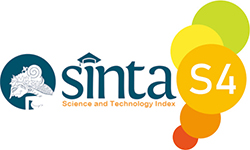THE IMPORTANCE OF TRUST IN TEACHER-STUDENT COMMUNICATION IN SCHOOL
DOI:
https://doi.org/10.35794/jmbi.v12i1.59535Abstract
The communication between teachers and students can be considered as an important type of communication since it naturally involves the topic of education, life, knowledge, etc., especially when it is conducted in the school scope. Trust has been an element in communication, which promotes understanding and collaboration between the parties involved. It is important to finally realize that trust is a powerful element for teachers and senders to achieve intended goals.
This study aims to elaborate, share and emphasize that teacher-student communication in school can be deemed effective and proper, when trust is put as the main element inside it. This study leans on the methodology of literature review where the process of summarizing, synthesizing and/or critiquing the literature are combined, identifying the developments in the topic of trust, with focus on its use between teachers and students in school.
It is true that trust is of high importance for teachers and students in doing communication when they are in school, and this situation also assures that trust is type of capital that is generally essential for interaction between parties.
References
Adams, C. M., & Forsyth, P. B. (2009). The Nature and Function of Trust in Schools. Journal of School Leadership, 19(2), 126-152. https://doi.org/10.1177/105268460901900201
Bjørnskov, C., 2009. Social trust and the growth of schooling. Economics of Education Review, 28, 249–257.
Bryk, A. S., & Schneider, B. (2002). Trust in schools: A core resource for improvement. New York: Russell Sage Foundation.
Coleman, J., 1988. Social capital in the creation of human capital. The American Journal of Sociology, 94, S95–S120.
Dewey, J. (1916). Democracy in education. New York: Macmillan.
Dobransky, N. D., & Frymier, A. B. (2004). Developing teacher-student relationships through out of class communication. Communication Quarterly, 52(3), 211–223. https://doi.org/10.1080/01463370409370193.
Englund, T. (2006). Deliberative communication: A pragmatist proposal. Journal of Curriculum Studies, 38, 503–520.
Fjeldstad, D., & Mikkelsen, R. (2003). Strong democratic competence does not automatically lead to strong engagement and participation. International Journal of Educational Research, 39, 621-632.
Forsyth, P. B., & Adams, C. A. (2008). Control of trust. A paper presented at the annual meeting of the American Educational Research Association, New York, NY.
Fox, R. M., & DeMarco, J. P. (2001). Moral reasoning (2nd ed.). Fort Worth, TX: Harcourt College Publishers.
Galindo-Pérez-de-Azpillaga, L., Foronda-Robles, C. & García-López, A. The Value of Trust: An Analysis of Social Capital in Natural Areas. Soc Indic Res 118, 673–694 (2014). https://doi.org/10.1007/s11205-013-0427-3
Harfitt, G. J. (2014). Brokering dialogue between secondary students and teachres to co-construct appropriate pedagogy in reduced-size classes. Teachers and Teaching, 20(2), 212–228.
Hughes, L. W. (197 4). ''Achieving Effective Human Relations and Morale:' In Performance Objectives for Principals: Concepts and Instruments, J. A. Culbertson, C. Henson and R. Morrison, eds. Berkeley, CA: McCutchan, pp. 121-151 .
Jones, K. (1996). ‘Trust as an Affective Attitude’, Ethics 107, pp. 4–25.
Kinchin, I. M. (2003). Effective teacher ↔ student dialogue: A model from biological education. Journal of Biological Education, 37(3), 110–113. https://doi.org/10.1080/00219266.2003.9655864
McGrath, K. F., & Van Bergen, P. (2015). Who, when, why and to what end? Students at risk of negative student–teacher relationships and their outcomes. Educational Research Review, 14, 1–17. doi:10.1016/j.edurev.2014.12.001
Myers, S. A., & Claus, C. J. (2012). The relationship between students’ motives to communicate with their instructors and classroom environment. Communication Quarterly, 60(3), 386– 402. https://doi.org/10.1080/01463373.2012.688672.
Ouchi, W. 198 1 . Theory Z. Reading, MA: Addison-Wesley.
Palincsar, A. S. (1986). The role of dialogue in providing scaffolded instruction. Educational Psychologist, 21(1–2), 73–98. https://doi.org/10.1080/00461520.1986.9653025.
Pawlowska, D. K., Westerman, J. W., Bergman, S. M., & Huelsman, T. J. (2014). Student personality, classroom environment, and student outcomes: A person–environment fit analysis. Learning and Individual Differences, 36, 180–193. https://doi.org/10.1016/J.LINDIF.2014.10.005.
Platz, M. (2021) Trust between teacher and student in academic education at school. Journal of Philosophy of Education, 55: 688–697. https://doi.org/10.1111/1467-9752.12560
Raufelder, D., Nitsche, L., Breitmeyer, S., Keßler, S., Herrmann, E., & Regner, N. (2016). Students' perception of "good" and "bad" teachers – Results of a qualitative thematic analysis with German adolescents. International Journal of Educational Research, 75, 31–44.
Sabol, T. J., & Pianta, R. C. (2012). Recent trends in research on teacher-child relationships. Attachment and Human Development, 14(3), 213–231. https://doi.org/10.1080/14616734.2012.672262.
Simpson, Thomas W. (2012). Pacific Philosophical Quarterly 93; 550–569 DOI: 10.1111/j.1468- 0114.2012.01438.x University of Southern California and Blackwell Publishing Ltd.
Thornberg, R., & Elvstrand, H. (2012). Children’s experiences of democracy, participation, and trust in school. International Journal of Educational Research, 53, 44– 54. doi:10.1016/j.ijer.2011.12.010
Wubbels, T., & Brekelmans, M. (2005). Two decades of research on teacher-student relationship in class. International Journal of Educational Research, 43(1–2), 6–24.
Zak, P., Knack, S., 2001. Trust and growth. The Economic Journal 111, 295–321.
Zand, D. E. 1972. "Trust and Managerial Problem Solving;' Administrative Science Quarterly, 17:229-239.









